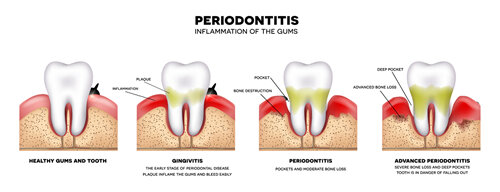Dental disease in dogs, more common than you think!
Dental disease affects around 80% of dogs from 3 years of age! In fact, it is the most common disease that we see in the dog. Clinical signs are often not apparent until the disease is advanced as dogs are incredibly good at hiding signs of pain. In addition, most dog owners are not very vigilant at checking the teeth of their canine companion.
Clinical signs we may see are:
- Bad breath
- Yellow/brown discolouration (tartar) around the gum line
- Red/swollen gums (gingivitis)
- Discolouration around the mouth and/or drooling
- Rubbing/pawing at the mouth
- Decreased appetite, difficulty eating, inactivity
- Swelling/bumps on the face
- Loose/missing teeth
What causes dental disease in dogs?
Humans commonly suffer from caries which is when bacteria in the mouth attack the enamel of the tooth to cause decay. This is uncommon in dogs. Dogs mainly suffer from periodontal disease, which is a painful inflammatory condition involving bacteria attacking the gums (gingiva), ligaments and bony tissues which support the teeth. Periodontal disease starts with food material and bacteria attaching to the surface of the tooth, this is called “plaque”. The plaque then mineralises and hardens on the surface of the tooth to form tartar, which is extremely hard to remove. Tartar often starts to form on the gum margin of the tooth and this starts to separate the gum from the tooth. Bacteria can then enter this pocket and attack the supporting structures of the tooth, including surrounding bone. In addition, the body amounts an immune response to attack the bacteria leading to inflammation. It is a progressive and often irreversible disease that eventually leads to the tooth becoming loose and falling out. The bacteria can lead to an abscess and may be shed into the blood stream to cause life threatening infections to the heart or other internal organs. Small breed dogs are more susceptible to periodontal disease due to overcrowding of their teeth and their smaller jaw size, but all breeds may be affected.
Another cause of dental disease in the dog is trauma as teeth are commonly broken when your dog is chewing hard toys/food.
It is estimated that 90% of pets will show marked improvement after dental treatment, such as increased energy, eating more comfortably, and less odorous breath, making your dog more pleasant to be around!
So, what can you do to help?
Firstly, you should get into the habit of regularly checking in your pets’ mouth, starting as a puppy so they get used to mouth examinations. Your veterinary surgeon will also check your pets’ mouth on routine examinations at the vet clinic.
If periodontal disease is present your dog will need a general anaesthetic for treatment to be effective. Your veterinary surgeon may recommend x-rays to check for damage to the surrounding bone/roots of the teeth which are not visible with oral examination. Treatment will then depend on the stage of the disease. With early periodontal disease your dog may only need ultrasonic scaling to remove the tartar on the tooth and under the gum margin. The tooth is then polished, which makes it more difficult for bacteria to adhere to the tooth after the procedure. As the disease progresses there are many more advanced procedures that can be performed to save the tooth, but this requires a dental specialist and commitment from the owner. If more than 50% of the surrounding structures of the tooth are lost then the only option is to remove the tooth, unfortunately this is the stage of disease that we often see as a veterinary surgeon. If your dog has a broken tooth and it involves the pulp cavity (nerve and blood vessels) in the centre of the tooth, then the only option is a dental specialist to perform a root canal procedure, or tooth extractions. If this tooth is left it will cause ongoing pain and bacteria can enter into the pulp cavity and cause both localised infection and spread to distant organs.
How can we prevent dental disease?
Prevention is definitely better than cure! So, what can we do at home to prevent this painful condition?
- Feed a good diet. Avoid soft wet foods which stick to the teeth, many premium dried foods/dental diets contain substances to help abrade and clean the teeth. The ‘Veterinary Oral Health Council’ only endorses foods/treats that are proven to help with periodontal disease – you can check the list online. Be careful with hard toys/chews eg bones, antlers, trotters or very hard toys. Make sure the toy can bend and has some ‘give’ to prevent breakage of teeth. Use chews or rubber toys specially designed to help with teeth cleaning. Clean your dog’s toys regularly to prevent a build-up of bacteria on the surface of the toy.
- Brush your dog’s teeth once to twice daily in order to dislodge the plaque before it mineralises into tartar. This sounds like a difficult task, but most dogs will accept brushing if approached in a gentle manner. Ideally begin gently brushing your dog’s teeth from a puppy. Start using a soft finger brush or soft cloth and gently rub a few teeth at a time. Use a canine toothpaste available at your vets and gradually progress to a soft long handled brush. Additional there are wipes available which can be easier to use. Do not use human toothpaste as it is not designed to be swallowed due to foaming agents and fluoride. Reward your dog after each session with praise/treats to make brushing a positive experience.



